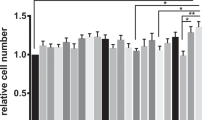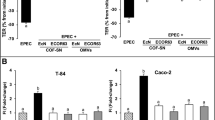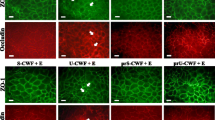Abstract
Lactobacillus plantarum (LP) has previously been used for the treatment and prevention of intestinal disorders and disease. However, the role of the LP surface layer adhesive protein (SLAP) in inhibition of epithelial cell disruption is not fully understood. The aim of the present study was to investigate the protective effects of purified SLAP on Caco-2 cells infected with enteropathogenic Escherichia coli (EPEC). The role of ERK in LP-mediated inhibition of tight junction (TJ) injury was also evaluated in order to determine the molecular mechanisms underlying the protective effects of LP in epithelial cells. SLAP was extracted and purified from LP cells using a porcine stomach mucin-Sepharose 4B column. SLAP-mediated inhibition of bacterial adhesion was measured using a competition-based adhesion assay. Expression of TJ-associated proteins, maintenance of TJ structure, and levels of extracellular signal regulated kinase (ERK) and ERK phosphorylation were assessed in SLAP-treated cells by a combination of real-time PCR, western blotting, and immunofluorescence microscopy. Cell permeability was analyzed by measurement of trans-epithelial electrical resistance (TER) and dextran permeability. The effect of SLAP on levels of apoptosis in epithelial cells was assessed by flow cytometry. Results from these experiments revealed that treatment with SLAP decreased the level of adhesion of EPEC to Caco-2 cells. SLAP treatment also enhanced expression of TJ proteins at both the mRNA and protein levels and affected F-actin distribution. Although ERK levels remained unchanged, ERK phosphorylation was increased by SLAP treatment. Caco-2 cells treated with SLAP exhibited increased TER and decreased macromolecular permeability, which was accompanied by a decrease in the level of apoptosis. Together, these results suggest that LP-produced SLAP protects intestinal epithelial cells from EPEC-induced injury, likely through a mechanism involving ERK activation.






Similar content being viewed by others
References
Whelan K, Myers CE (2010) Safety of probiotics in patients receiving nutritional support: a systematic review of case reports, randomized controlled trials, and nonrandomized trials. Am J Clin Nutr 91(3):687–703
Zhang M, Wang XQ, Zhou YK et al (2010) Effects of oral Lactobacillus plantarum on hepatocyte tight junction structure and function in rats with obstructive jaundice. Mol Biol Rep 37(6):2989–2999
Mack DR, Ahrne S, Hyde L, Wei S, Hollingsworth MA (2003) Extracellular MUC3 mucin secretion follows adherence of Lactobacillus strains to intestinal epithelial cells in vitro. Gut 52(6):827–833
Liu ZH, Ma YL, Shen TY, et al (2010) Identification of DC-SIGN as the receptor during the interaction of lactobacillus plantarum CGMCC 1258 and dendritic cells. World J Microbiol Biotechnol. doi:10.1007/s11274-010-0495-3. [Epub ahead of print]
Qin H, Zhang Z, Hang X, Jiang Y (2009) L. plantarum prevents enteroinvasive Escherichia coli-induced tight junction proteins changes in intestinal epithelial cells. BMC Microbiol 9:63
Liu Z, Zhang P, Ma Y, et al (2010) Lactobacillus plantarum prevents the development of colitis in IL-10-deficient mouse by reducing the intestinal permeability. Mol Biol Rep. doi:10.1007/s11033-010-0237-5. [Epub ahead of print]
Garcia-Lafuente A, Antolin M, Guarner F, Crespo E, Malagelada JR (2001) Modulation of colonic barrier function by the composition of the commensal flora in the rat. Gut 48(4):503–507
Gareau MG, Jury J, MacQueen G, Sherman PM, Perdue MH (2007) Probiotic treatment of rat pups normalises corticosterone release and ameliorates colonic dysfunction induced by maternal separation. Gut 56(11):1522–1528
Buck BL, Altermann E, Svingerud T, Klaenhammer TR (2005) Functional analysis of putative adhesion factors in Lactobacillus acidophilus NCFM. Appl Environ Microbiol 71(12):8344–8351
Francius G, Alsteens D, Dupres V et al (2009) Stretching polysaccharides on live cells using single molecule force spectroscopy. Nat Protoc 4(6):939–946
Johnson-Henry KC, Hagen KE, Gordonpour M, Tompkins TA, Sherman PM (2007) Surface-layer protein extracts from Lactobacillus helveticus inhibit enterohaemorrhagic Escherichia coli O157:H7 adhesion to epithelial cells. Cell Microbiol 9(2):356–367
Avall-Jaaskelainen S, Hynonen U, Ilk N et al (2008) Identification, characterization of domains responsible for self-assembly, cell wall binding of the surface layer protein of Lactobacillus brevis ATCC 8287. BMC Microbiol 8:165
Sara M, Sleytr UB (2000) S-Layer proteins. J Bacteriol 182(4):859–868
Granato D, Bergonzelli GE, Pridmore RD et al (2004) Cell surface-associated elongation factor Tu mediates the attachment of Lactobacillus johnsonii NCC533 (La1) to human intestinal cells and mucins. Infect Immun 72(4):2160–2169
Horie M, Ishiyama A, Fujihira-Ueki Y et al (2002) Inhibition of the adherence of Escherichia coli strains to basement membrane by Lactobacillus crispatus expressing an S-layer. J Appl Microbiol 92(3):396–403
Gopal PK, Prasad J, Smart J, Gill HS (2001) In vitro adherence properties of Lactobacillus rhamnosus DR20 and Bifidobacterium lactis DR10 strains and their antagonistic activity against an enterotoxigenic Escherichia coli. Int J Food Microbiol 67(3):207–216
Johnson-Henry K, Wallace JL, Basappa NS et al (2001) Inhibition of attaching and effacing lesion formation following enteropathogenic Escherichia coli and Shiga toxin-producing E. coli infection. Infect Immun 69(11):7152–7158
Johnson-Henry KC, Donato KA, Shen-Tu G, Gordanpour M, Sherman PM (2008) Lactobacillus rhamnosus strain GG prevents enterohemorrhagic Escherichia coli O157:H7-induced changes in epithelial barrier function. Infect Immun 76(4):1340–1348
Yan F, Polk DB (2002) Probiotic bacterium prevents cytokine-induced apoptosis in intestinal epithelial cells. J Biol Chem 277(52):50959–50965
Yan F, Cao H, Cover TL et al (2007) Soluble proteins produced by probiotic bacteria regulate intestinal epithelial cell survival and growth. Gastroenterology 132(2):562–575
Anderson JM, Van Itallie CM (1995) Tight junctions and the molecular basis for regulation of paracellular permeability. Am J Physiol 269(4 Pt 1):G467–G475
Basuroy S, Seth A, Elias B, Naren AP, Rao R (2006) MAPK interacts with occludin and mediates EGF-induced prevention of tight junction disruption by hydrogen peroxide. Biochem J 393(Pt 1):69–77
Ballif BA, Blenis J (2001) Molecular mechanisms mediating mammalian mitogen-activated protein kinase (MAPK) kinase (MEK)-MAPK cell survival signals. Cell Growth Differ 12(8):397–408
Rosseland CM, Wierod L, Oksvold MP et al (2005) Cytoplasmic retention of peroxide-activated ERK provides survival in primary cultures of rat hepatocytes. Hepatology 42(1):200–207
Liu ZH, He YP, Qin H (2010) The growth-inhibition effect of tamoxifen in the combination chemotherapeutics on the human cholangiocarcinoma cell line QBC939. Mol Biol Rep 37(6):2693–2701
Liu ZH, He YP, Zhou Y, Zhang P, Qin H (2010) Establishment and identification of the human multi-drug-resistant cholangiocarcinoma cell line QBC939/ADM. Mol Biol Rep. doi:10.1007/s11033-010-9975-7. [Epub ahead of print]
Liu ZH, Ma YL, He YP et al. (2010) Tamoxifen reverses the multi-drug-resistance of an established human cholangiocarcinoma cell line in combined chemotherapeutics. Mol Biol Rep. doi:10.1007/s11033-010-0291-z. [Epub ahead of print]
Prisciandaro L, Geier M, Butler R, Cummins A, Howarth G (2009) Probiotics and their derivatives as treatments for inflammatory bowel disease. Inflamm Bowel Dis 15(12):1906–1914
Haller D, Antoine JM, Bengmark S et al (2010) Guidance for substantiating the evidence for beneficial effects of probiotics: probiotics in chronic inflammatory bowel disease and the functional disorder irritable bowel syndrome. J Nutr 140(3):690S–697S
Rioux KP, Madsen KL, Fedorak RN (2005) The role of enteric microflora in inflammatory bowel disease: human and animal studies with probiotics and prebiotics. Gastroenterol Clin North Am 34(3):465–482 ix
Dieleman LA, Goerres MS, Arends A et al (2003) Lactobacillus GG prevents recurrence of colitis in HLA-B27 transgenic rats after antibiotic treatment. Gut 52(3):370–376
Bousvaros A, Guandalini S, Baldassano RN et al (2005) A randomized, double-blind trial of Lactobacillus GG versus placebo in addition to standard maintenance therapy for children with Crohn’s disease. Inflamm Bowel Dis 11(9):833–839
Land MH, Rouster-Stevens K, Woods CR et al (2005) Lactobacillus sepsis associated with probiotic therapy. Pediatrics 115(1):178–181
Apostolou E, Kirjavainen PV, Saxelin M et al (2001) Good adhesion properties of probiotics: a potential risk for bacteremia? FEMS Immunol Med Microbiol 31(1):35–39
Liong MT (2008) Safety of probiotics: translocation and infection. Nutr Rev 66(4):192–202
Chen X, Xu J, Shuai J et al (2007) The S-layer proteins of Lactobacillus crispatus strain ZJ001 is responsible for competitive exclusion against Escherichia coli O157:H7 and Salmonella typhimurium. Int J Food Microbiol 115(3):307–312
Kaper JB, Nataro JP, Mobley HL (2004) Pathogenic Escherichia coli. Nat Rev Microbiol 2(2):123–140
Chaturvedi LS, Marsh HM, Shang X, Zheng Y, Basson MD (2007) Repetitive deformation activates focal adhesion kinase and ERK mitogenic signals in human Caco-2 intestinal epithelial cells through Src and Rac1. J Biol Chem 282(1):14–28
Zhang J, Owen CR, Sanders MA, Turner JR, Basson MD (2006) The motogenic effects of cyclic mechanical strain on intestinal epithelial monolayer wound closure are matrix dependent. Gastroenterology 131(4):1179–1189
Howe KL, Reardon C, Wang A, Nazli A, McKay DM (2005) Transforming growth factor-beta regulation of epithelial tight junction proteins enhances barrier function and blocks enterohemorrhagic Escherichia coli O157:H7-induced increased permeability. Am J Pathol 167(6):1587–1597
Chaturvedi LS, Gayer CP, Marsh HM, Basson MD (2008) Repetitive deformation activates Src-independent FAK-dependent ERK motogenic signals in human Caco-2 intestinal epithelial cells. Am J Physiol Cell Physiol 294(6):C1350–C1361
Seth A, Yan F, Polk DB, Rao RK (2008) Probiotics ameliorate the hydrogen peroxide-induced epithelial barrier disruption by a PKC- and MAP kinase-dependent mechanism. Am J Physiol Gastrointest Liver Physiol 294(4):G1060–G1069
Walter J, Loach DM, Alqumber M et al (2007) D-alanyl ester depletion of teichoic acids in Lactobacillus reuteri 100-23 results in impaired colonization of the mouse gastrointestinal tract. Environ Microbiol 9(7):1750–1760
Sun J, Le GW, Shi YH, Su GW (2007) Factors involved in binding of Lactobacillus plantarum Lp6 to rat small intestinal mucus. Lett Appl Microbiol 44(1):79–85
Hayes M, Ross RP, Fitzgerald GF, Hill C, Stanton C (2006) Casein-derived antimicrobial peptides generated by Lactobacillus acidophilus DPC6026. Appl Environ Microbiol 72(3):2260–2264
Acknowledgments
The authors thank Shanghai Jiao Tong University Affiliated Sixth People’s Hospital for technical assistance with this study. This study was supported by the National Natural Science Foundation of China (No. 81070293) and the National Basic Research Program of China, Ministry of Science and Technology of the People’s Republic of China (No. 2008CB517403).
Author information
Authors and Affiliations
Corresponding author
Additional information
Zhihua Liu and Tongyi Shen are co-first authors.
Electronic supplementary material
Below is the link to the electronic supplementary material.
Rights and permissions
About this article
Cite this article
Liu, Z., Shen, T., Zhang, P. et al. Lactobacillus plantarum surface layer adhesive protein protects intestinal epithelial cells against tight junction injury induced by enteropathogenic Escherichia coli. Mol Biol Rep 38, 3471–3480 (2011). https://doi.org/10.1007/s11033-010-0457-8
Received:
Accepted:
Published:
Issue Date:
DOI: https://doi.org/10.1007/s11033-010-0457-8




